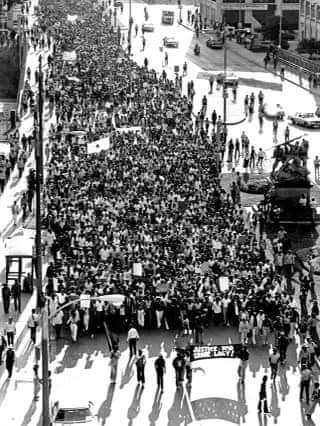On June 9, 1981, Ernest Lacy was working as a painter in an apartment building at Wisconsin Ave. and 20th St. on Milwaukee’s west side. It was so hot that summer that it was impossible to paint during the day and even then the nighttime heat was grueling. At 10 p.m., he took a break to walk three blocks to a 24-hour pantry to get food and water, knowing nothing about a sexual assault that had happened a few blocks away. At 23rd St., Lacy was confronted by a group of police officers who were looking to put their hands on the first Black man they encountered.
“Earlier that day these officers were supposed to go on trial in front of Milwaukee Fire and Police Commission for brutalizing a man they had previously arrested, but their trial was postponed and instead they were on the street,” said Jackie Bogenberger, who recently read a retelling of the events on behalf of the Lacy family. The officers handcuffed, tortured and killed Lacy, driving a knee into his back while they bent his arms up over his head, causing him to have a seizure and die in the back of a police van. He was 22. Even though it was clear that he was in medical crisis, paramedics were not called to the scene and the police continued to drive around, arresting other Black men with Lacy dead in the back.
In response, the community in Milwaukee rose up to support the Lacy family and demand that the police be held accountable for the indiscriminate killing of a young Black man, a worker, a “beautiful soul” according to his childhood friend Lavita Booker, who spoke with Liberation News. Thousands of people took to the streets for weeks in the wake of the killing of Lacy, “Ten thousand strong every day,” according to Mertyl Lacy, Ernest’s 88-year-old mother. This sustained action forced the state to take up an official inquest, which resulted in the firing of one officer and the demotion of four others, as well as bringing into existence the Lacy Law, passed in the Wisconsin State Legislature in 1983. The Lacy Law made it illegal for police officers, firefighters and paramedics to fail to render aid, a violation that becomes a felony if the failure to render results in death. The struggle of the people in the streets made this law possible.

However, the inquest only resulted in the firing of one officer. He faced no consequences besides the temporary disruption of his career. The others remained with the Milwaukee Police Department after serving a brief suspension. While the Lacy Law is officially on the books, there have been several instances when police have failed to render aid to people they had detained, leading to their deaths. Notable cases were the killings of Derek Williams in 2011, who suffocated to death in the back of a police car while MPD officers mocked him, and Adam Tramell, who was electrocuted after being tased while in the shower by West Milwaukee Police during a wellness check in 2017. In both these cases, police used violence against a Black person, severely injuring them, then refused to render medical aid until it was too late. These are clear violations of the Lacy Law, but the perpetrating officers faced no consequences. “It isn’t just about Ernest, there is someone dying every day,” said Mertyl Lacy. “There are hundreds of other Ernest Lacys out there that have been murdered, whose families have been deprived of justice.”
Forty years to the exact minute Ernest Lacy was killed, the Lacy family, activists from The People’s Revolution and community members gathered at the same intersection where Lacy died. More than 100 people joined members of the Lacy family to commemorate Ernest and renew the call for justice, not only for Ernest, but for all victims of police terror.
“It makes me feel so happy inside for 40 long years there are still people who are willing to take the time to come and say we can’t take anymore, we have to keep on fighting,” said Myrtle Lacy. “It is just sad, and the emptiness that you feel inside, you will never ever understand unless you lost a child. When you lose a child, it is a feeling that is almost unexplainable.” Myrtle, along with Ernest’s youngest brother Cecil took the time to recognize the trauma that is inherent in losing a child to racist police terror, recognizing the families of Syville Smith, Jay Anderson, Alvin Cole, Joel Acevedo, Dantre Hamilton, Antonio Gonzalez and Christopher Davis and their continued battles for justice.
At 23rd and Wisconsin, as the time arrived when police violently squeezed the life out of Ernest Lacy 40 years earlier, Cecil Lacy spoke about what his family has gone through and the systematic nature of police murders of Black and Brown people. “This is the ultimate pain. It is always staring you in the face. All you have to do is look at the news all around you, city to city, state to state. Black and Brown people are dropping at epic proportions and it is sad. When you have a corrupt system of policing, a corrupt system with the DA, all the way up to the White House, it is time for a change. These people really don’t have any empathy or any compassion for people that lose their lives.”
Cecil Lacy then spoke about how his brother was treated by the media in the wake of his death and how this process has been replayed over and over again as the police try to justify their terrorism. “What they do is try to figure out how to get out from under the situation they caused. They try to criminalize the family. They try to villainize the person that they murdered. The first thing that they do is try to find out anything they can about the person in order to justify their evil behavior toward the person that is the victim. The first thing that the police want to do is look in the inner city at Black boys and girls and treat them like they are animals. Basically all they want to do is incarcerate, kill and abuse them. It is time for us to come together. Black people have been brutalized since the day they came on this American soil. We have been on the hit list since the day we came out of the womb. And what they are doing is getting more sophisticated at it because they want to exterminate us.”
Feature photo: Milwaukee activists commemorate the police killing of Ernest Lacy in 1981. Liberation photo






